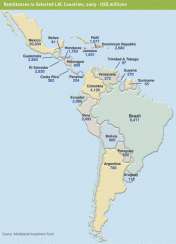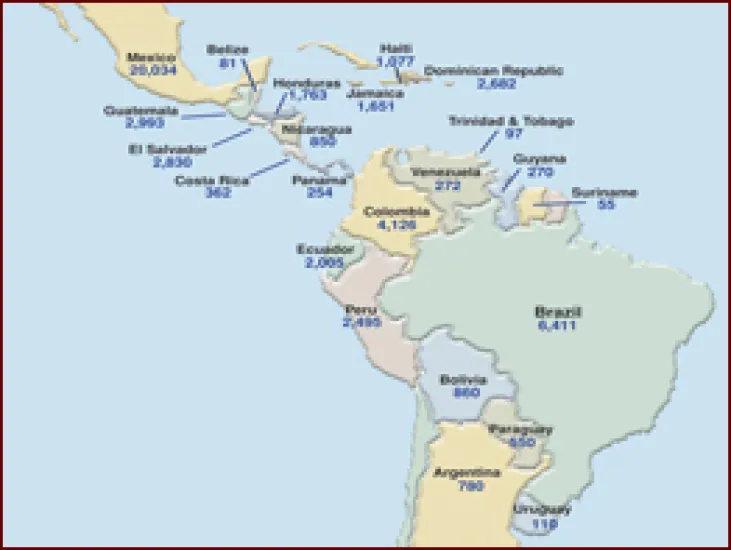By Donald Terry, Manager, and Pedro de Vasconcelos, Coordinator, Remittance Program
Multilateral Investment Fund

Call it the case of the missing billions. For decades, millions of migrant workers have been sending billions of dollars back to their home countries to support their families. Yet the impact of these huge international flows of both money and workers is only now beginning to be understood even though these flows of both money and people have been hidden in plain sight for decades. Why? Because the money is sent regularly in small amounts, usually outside the formal financial system; and the workers typically live on the margins of society.
All of this is now changing. Remittances are widely recognized as critical to the survival of millions of individual families, and the health of many national economies throughout Latin America and the Caribbean (LAC). Unlike foreign aid, migrant remittances go directly to families in places that are often difficult to reach with development assistance. And while international capital flows have fluctuated with market cycles, remittances have increased, even during economic recession.
In 2005 remittances to LAC totaled more than US$53.6 billion (a 17% year-on-year increase) making the region the largest remittance market in the world. This amount exceeded, for the third consecutive year, the combined flows of all net foreign direct investment (FDI) and official development assistance (ODA) to the region. At over US$20 billion in 2005, Mexico remains the largest recipient of remittances, followed by Brazil and Colombia which for the first time reached over US$6 and US$4 billion respectively. Central America and the Dominican Republic combined reach over US$11 billion; and the Andean countries total almost US$9 billion.
Given the complicated process of tracking informal flows (particularly those still carried by hand) actual flows could be at least 10% higher. Despite these accounting and reporting challenges many central banks throughout the region have made significant progress of in providing more accurate remittances information, notably those in Colombia, El Salvador, Guatemala, Honduras, Jamaica, and Mexico.
It is currently estimated that over 25 million LAC-born adults are living outside their country of origin. Approximately 65% send money home on a regular basis, typically $100/$200/$300 a month, resulting in about 200 million separate financial transactions a year. Transaction costs to send these remittances have fallen by more than 50% over the past five years due largely to increased competition and better use of technology.
About 75% of LAC remittances are sent from the United States (US$40billion) while remittances from Western Europe – particularly, Spain, Italy, Portugal, and the United Kingdom – account for almost 15% of the market (US$7.5 billion). Other large flows come from Japan to Brazil and Peru (see "Japan's Latin American Ex-Pats", on page 12), Canada to Jamaica and Haiti with intraregional flows accounting for the rest.
In Search of Opportunity
Family by family, worker by worker, migrants are redrawing the map of global labor markets. There are approximately 22 million LAC economic migrants living in the developed economies of North America, Europe, and Japan, while another 3 to 5 million work in neighboring countries in Latin America or the Caribbean. Over the past quarter century, economic migration has increased at four times the rate of world population growth — globalization is clearly accelerating the scale and scope of remittances.
The basic economic equation in the Americas, as for the rest of the world, is quite simple: developed countries need migrant labor, and families back home need the remittances that come from migrant earnings. Each year, millions of individuals, both men and women, continue to leave their villages and hometowns to seek jobs and better lives for themselves and their families. At approximately 175 million economic migrants could constitute the sixth most populous country in the world.
The process is profoundly entrepreneurial. Facing increasingly limited prospects at home, workers in Latin America and the Caribbean – particularly from rural areas – are bypassing their own cities in favor of moving directly abroad. Like entrepreneurs who seek markets around the world, foreign workers cross borders in search of comparative advantages. And as people move "North" by the millions, money moves "South" by the billions.
But the driving force behind this phenomenon remains a fundamentally human connection: a commitment to family values lies at the core of these flows. As a result, new networks of social and economic connections are being formed. These are transnational families, living and contributing to two countries, two economies, and two cultures at the same time. Shifts in international trade, investment, and communication have required the world's political and economic systems to adopt new rules and mechanisms to meet modern realities. The same needs to be done for the migrant laborers who have become such an integral part of the world's labor markets.
Promoting Financial Democracy
If individual remitters and their families are too often invisible, the economic power of millions of the poor is becoming increasingly evident. In fact, the dividing line between the poor and the non-poor is less about the existence of assets than about the use of these assets. A key factor in development is for the poor to have access to financial services in order to unlock and leverage their own assets. If people living and working at the base of the economic pyramid have more options available to them, they can better leverage their assets for the benefit of their families and the communities where they live. Unfortunately, LAC financial systems, as in the rest of the developing world, remain essentially irrelevant to the daily lives of the vast majority of their populations. For example, less than 10% of LAC remittance recipients are estimated to currently have access to banking accounts, loans or other basic financial services.
As a result, remittances remain financial flows in search of financial products. In this context, the huge scale of remittances to Latin America and the Caribbean presents an enormous opportunity for millions of families to enter the world's financial mainstream: to open a savings account, or obtain a small business loan or housing mortgage. This can be a critical first step on the pathway to credit for individual families; and reaching the goal of financial democracy for a nation.
Over the past five years, the process of sending remittances has undergone dramatic changes. However, over the next five years, the system can be entirely transformed, moving from the current "cash-to-cash" system into the electronic or digital transfer system of "accounts-to-accounts." The technology is already available; what is needed are innovative business plans and appropriate regulatory frameworks. The cost of sending money home will continue to fall; the focus for the future is the chance to bring millions upon millions of transnational families into the financial system where their remittances can help effect fundamental change.
The Ultimate Challenge
Remittances do not constitute a development strategy. Indeed, they reflect the general failure of development across most LAC countries. Nor should family remittances be viewed in any way as a substitute for, or an alternative to, the sound government policies and programs that are necessary for broad-based and sustainable economic growth.
But remittances, particularly if leveraged through the financial system, can mobilize savings and promote investment in small enterprises, housing, and education. For example, microfinance institutions and credit unions can be significantly strengthened with increased remittance flows, housing can spark an entire range of local economic activity, and bond issues can be securitized for on-lending to small businesses. Improved education can lead to higher productivity and increased national competitiveness.
In short, remittances can be an important part of any long-term solution leading to a future when such large numbers of young men and women are no longer forced to make the painful choice to leave home in order to provide for their families, and pursue the prospect of a better life for their children.
A day will come when the next generation can find opportunity in their own communities, and no longer have to cross national borders to find work. In the meanwhile, millions of individual decisions will continue to be made each year to migrate, and send back remittances. These decisions will be grounded in the reality of the lives of the families involved, not by some econometric model, abstract theory, or government policy.
Today, one out of every ten persons around the globe is directly involved with remittances – 125 million migrant workers regularly sending money to support another 500 million relatives back home. There is a need to provide these millions of hard-working migrants and their families with more options to use their own money... They will do the rest.






